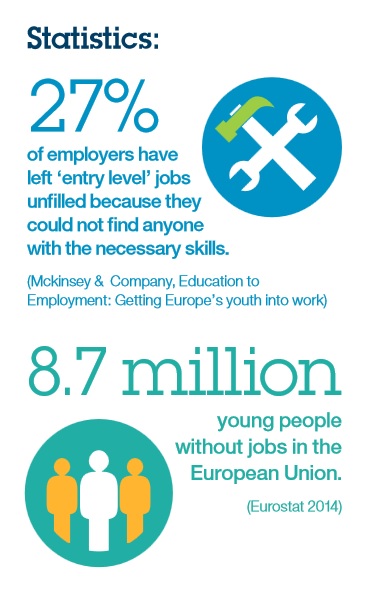Generic
Pact for Youth, achieving a new level of partnership
18/11/2015 | Written by: Think Blog redactie (0cB)
Categorized: Generic
Share this post:

Jacques Platieau, Country General Manager IBM Belgium, Luxembourg
A recent McKinsey (2014) showed that in Europe about 7M youngsters are unemployed. Surprisingly, the same study stated that about 27 % of the European employers have jobs, but don’t find the right candidates to fill the vacancies. It’s a strange paradox that raises question on how we prepare our youth for employment.
At the same time our business and society are in transformation, a digital transformation. We’re entering the cognitive era, a new era for technology, business and thinking. Technology will access data in all its forms, will understand it, learn from it and technology will reason through it. It is an essential transformation for business but also for a sustainable and inclusive society. It implies the creation of thousands of new jobs. These jobs require new skills. And here lies Europe’s challenge. We don’t have these skills yet. Europe does not have a pool of talent anymore to address this challenge.
In the ICT-industry, we estimate that by 2020 we have 900.000 open vacancies. This is an acute problem for our industry. But with the world digitalizing at rapid speed, this will become soon a very acute problem for all industries.
Yesterday, in the presence of King Filip of Belgium, European commissioner Marianne Thyssen and European Parliament President Martin Shulz together with big enterprises like IBM, Nestlé, Solvay and many others, launched the Pact for Youth. The pact is about achieving a new level of partnership. It involves CSR/business, education, youth and the European institutions to deliver the required skills and employability to support growth of new jobs in Europe.
We need this partnership also to ensure that the European Youth is equipped with the right skills needed for these new jobs. We need to work to close the skills gaps by increasing the level of partnership between education and industry and we need also to bring innovation on the way to succeed this challenge.
Many new jobs are created in new areas. We did not even imagine them a few years ago. For example, explosion of data and its key role for business and society creates a huge need for data analytics skills. Another example is the complete reinvention of the way to engage with companies, business, people through mobile & social technology explosion, think to the APPS developed every day or to the social networks, it creates a need of new skills. Many other examples, I could mention the biotechnology, high value, high skills area, renewable forms of energy the same. All these areas require new skills, many in the STEM topics and also new mindset, more entrepreneurial. We can all be innovators.
To succeed this challenge, we need more collaboration between industry and education. This is the objective of the STEM alliance, to bring together multiple industries with the Ministries of Education to ensure students & teachers are learning the skills and knowledge to equip them for the new jobs.
IBM is a driving force, both in the STEM-alliance as in the Pact for Youth. And we do what we preach. IBM is helping to increase student engagement in STEM and align the worlds of education and employment through a portfolio of education offerings and skills-based volunteering. We organize workshops for more then 22.000 students through more than 1.000 sessions, or 1-to-1 mentoring sessions with about 1500 teachers. We organize STEM camps, etc. I n total 2.700 IBM employees are involved in STEM initiatives.
In the UK, France and Turkey, we invite teachers to spend 1 or 2 weeks at industry. They can take a lot of new insight back to the classroom. To make this sustainable, we offer the teacher an industry mentor for continued connection to business.
In Belgium, we successfully implemented Extreme Blue, that gives the opportunity to students to get exposed to real client projects for a period of 6 to 8 weeks under the mentoring of IBM employees.
Finally, we need to innovate across the education and training systems. A good illustration of that is about the vocation education. We need to find new ways to deliver the skills for the “middle jobs” that require high competence but not necessarily a university degree. One way to do this is to eliminate the silos between school and vocation education. The dual system in Germany and other countries is an example.
In IBM, we have 2 successful initiatives:
- In the US, we have introduced a radical new approach that integrates school and vocational college in one 6 year system. It has the support of President Obama and next year, there will be 100 schools with such an initiative.
- In the UK, 4 years ago, we introduced a new apprenticeship programme. Before that we had 100% graduate hire. This innovation has been very successful, the students mostly get jobs at IBM on completion.
We invite more business to join in all these partnerships, the pact for youth, the STEM alliances to help our young people to get equipped with the right skills for all the new job opportunities we see coming and at the end, to serve and contribute to a sustainable and inclusive society.
Automate work and accelerate business growth
Many companies need help to navigate the rapid changes that define today’s business environment. To improve their responsiveness and flexibility, they are looking for new ways of conducting business, rethinking their processes, and investing in digital transformation projects to increase the robustness of their operations. They rely on business automation technologies to cut out repetitive […]
Sustainability and the technologies enabling the transition
Creating a sustainable future demands significant technological innovation to decarbonize society, restore biodiversity and ecosystem health, foster thriving oceans for sustenance and economic growth, remove atmospheric carbon, transition to sustainable agriculture, and advance eco-friendly cities that align with our vision for a better future. Generative AI has achieved much in recent years and now surpasses […]
Technology in action at Think Summit 2021
Covid 19, the energy transition and climate change require business agility… right away! Organizations that are slowly starting their digital transformation are irrevocably overtaken by competitors: companies that can quickly realize new, sustainable business models with a remote workforce. How can organizations leverage innovations such as AI, machine learning and hybrid cloud to make […]




